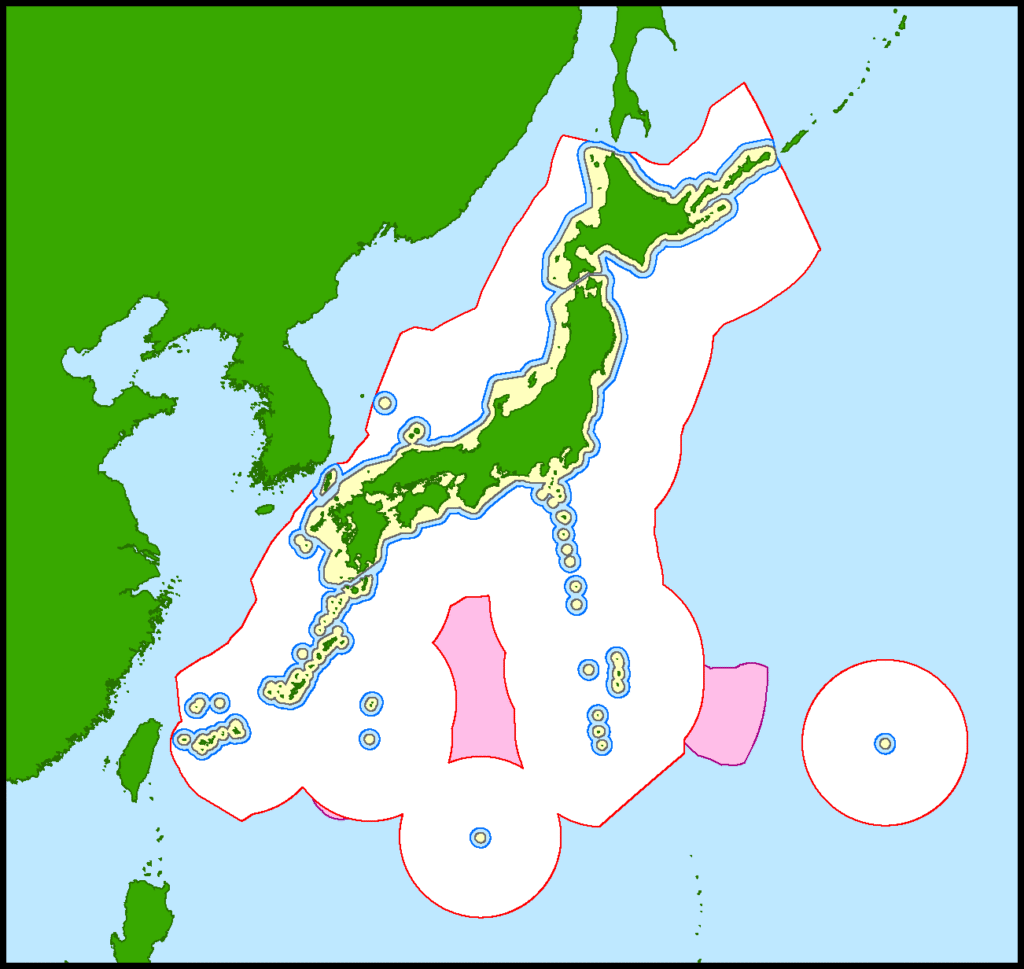Japan is an island nation surrounded by the sea. Its territory includes not only visible land but also maritime areas. This article introduces the elements that constitute Japan’s territorial extent, such as national land area, territorial waters, and economic zones.
What Is a National Territory?
A “territory” is the space over which a state exercises sovereignty. Specifically, it consists of three components:
- Land (territory): The actual land areas including Honshu, Hokkaido, Shikoku, Kyushu, and the outlying islands.
- Territorial waters (sea area): The sea extending a certain distance from the coast.
- Airspace: The air above the land and territorial waters.
Within these three domains, the state fully exercises its sovereignty through laws and administration.
Japan’s National Land Area
The land area of Japan is about 378,000 square kilometers.
This size ranks around 60th among approximately 190 countries in the world and is comparable to the following countries:
- Germany (about 357,000 square kilometers)
- Vietnam (about 330,000 square kilometers)
- Finland (about 338,000 square kilometers)
As an island nation, Japan consists of the four main islands (Hokkaido, Honshu, Shikoku, and Kyushu) and thousands of smaller islands. The more distant islands, such as Okinawa, the Nansei Islands, and the Ogasawara Islands, are also part of Japan’s national land.
Japan’s Territorial Waters and Exclusive Economic Zone (EEZ)
Since Japan is a country surrounded by the sea, maritime areas are also important parts of its territory.
What Are Territorial Waters?
Territorial waters are sea areas extending 12 nautical miles (about 22.2 km) from Japan’s coastline. Within this zone, Japan’s sovereignty applies completely. Japanese laws are enforced, and the country has the authority for policing and exclusive control.
For example, if a suspicious vessel enters territorial waters, the Japan Coast Guard can investigate, warn, and expel it.
What Is an Exclusive Economic Zone (EEZ)?
The EEZ, or Exclusive Economic Zone, refers to sea areas extending up to 200 nautical miles (about 370 km) from the coastline. Within this zone, Japan has exclusive rights to explore, develop, and manage resources.
Unlike territorial waters, however, foreign vessels and aircraft are generally free to pass through. The EEZ mainly grants Japan priority rights regarding economic activities such as fishing, seabed resources, and marine energy.
Extent of the 200 Nautical Mile EEZ
Japan’s EEZ covers about 4.47 million square kilometers. This is about 12 times the size of Japan’s land area and ranks around 6th in the world.
The reason Japan’s EEZ is so large is that it possesses many outlying islands, such as:
– The Ogasawara Islands (Tokyo)
– Minamitorishima (Tokyo)
– Okinotorishima (Tokyo)
– Yonaguni Island and the Senkaku Islands (Okinawa Prefecture)
– Etorofu and Kunashiri Islands in the Northern Territories (claimed by Japan)
Because a 200-nautical-mile EEZ is set around these islands, Japan possesses vast maritime areas relative to its relatively small land area.
Japan as a Maritime Nation
Japan’s EEZ is believed to contain abundant fishery resources, seabed minerals, and energy sources such as methane hydrate. It is also an important passage for shipping routes, playing a key role in both the economy and national defense.
At the same time, in sea areas where boundaries overlap with neighboring countries, diplomatic negotiations are often required over fishing rights and resource management.
In Conclusion
Japan’s “territory” includes not only land but also maritime areas and airspace. Especially when including the 200-nautical-mile EEZ, Japan can be considered one of the world’s leading maritime nations.
This vast territorial extent is deeply tied to Japan’s food supply, national security, and energy policy, and its geographical features will continue to have a major impact on the country’s future.




Comments